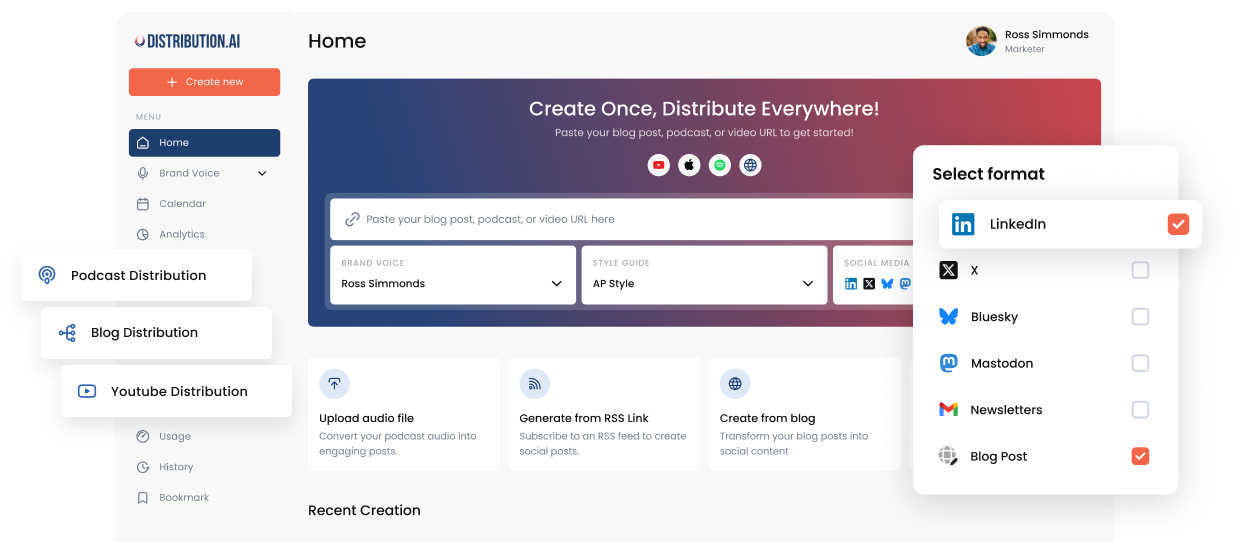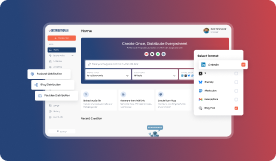11 Marketing Strategies to Drive the Results You Want
Planning your marketing strategies? Discover the unique strategies to market your brand, with real-life examples that can take your brand to the next level.

Marketing is rapidly evolving. And every year it offers something new. Keeping up can be challenging.
However, if you simply flow with the trends just to “keep up,” it’s going to cost you money, resources, and even your customers. Instead, you should know what goals you’re trying to achieve, what your audience resonates with, and how to keep them engaged.
Marketers now need to think beyond conventional approaches and leverage creativity, data, and connection to elevate growth marketing principles. Let’s break down the marketing strategies that can steer your brand toward success.
What are Marketing Strategies?
A marketing strategy is a clear, comprehensive plan that guides how a business attracts, engages, and retains its target audience. It is the roadmap that connects your business objectives with the right marketing channels to reach your potential customers.
Instead of running random campaigns, a well-crafted marketing strategy ensures your marketing efforts are consistent, measurable, and aligned with your business goals.
A well-structured marketing strategy usually covers:
- Target audience: Who exactly are you trying to reach?
- Key brand messaging: What do you want customers to remember about you?
- Marketing channels: Where will you show up (social media, SEO, email, paid ads)?
- Business objectives: What are the outcomes you are trying to achieve (brand awareness, lead generation, sales growth)?
- Measurement: What are the metrics to track for measuring progress?
When done right, marketing strategies can increase brand awareness, improve customer engagement, and positively impact conversions. Let’s see how you can create one for your brand.
How to Create a Marketing Strategy?
Here’s a 7-step framework to help you create a comprehensive marketing strategy:
Step 1: Conduct market research
Understand your target market, market trends, and customer behavior to create effective marketing strategies.
For instance, a skincare brand can run Instagram polls and use social listening tools to learn what products Gen Z actually wants. They might discover conversations around the growing demand for fragrance-free or organic products, helping the startup shape its product. Attending startup networking events can also provide direct feedback from potential customers and industry peers, adding another layer of insight to guide product decisions.
Step 2: Define business goals
Tie your marketing plan to business growth goals. If you want to increase sales, set a clear objective: Increase free trial sign-ups by 15% in 2 months.
Similarly, for enhancing customer satisfaction, your objective could be: To increase customer satisfaction (CSAT) scores by 10% within 6 months.
Step 3: Identify your target audience
Use customer data to build buyer personas. Consider customer pain points, motivations, frustrations, demographics, and preferred social media platforms.
For instance, a fitness app analyzes downloads/sign-ups data and finds out that most new users are professionals aged between 25 – 40 years. Based on this insight, the brand can adjust its marketing strategies to focus more on quick workout routines, easy diet recipes for busy schedules.
Step 4: Select marketing channels
Choose both online and offline channels for marketing. Social media marketing, search engine marketing, email marketing, or influencer marketing, depending on your audience.
If you’re a B2B startup targeting company decision-makers like founders, CEOs, CFOs, or Marketing Directors, choose LinkedIn and Twitter (now X) for social media marketing, search engine marketing, and email marketing.
On the other hand, if you’re a fashion startup with the most active audience on Instagram, consider Instagram Reels for promotion. You can collaborate with influencers to increase your reach and credibility.
Step 5: Craft brand messaging
Define your brand positioning and craft a key message that aligns with what you offer and resonates best with the target audience. Develop content marketing and social media marketing strategies, create videos, tutorials, and demos that resonate with the audience. Make sure your overall marketing strategy reflects a consistent brand voice and personality.
For example, Distribution AI positions itself with a simple, consistent message across website, emails, and social media campaigns: “An all-in-one tool for content repurposing.” It shows exactly how it helps—repurposing blogs, videos, and podcasts into text posts, LinkedIn carousels, infographics, and images.
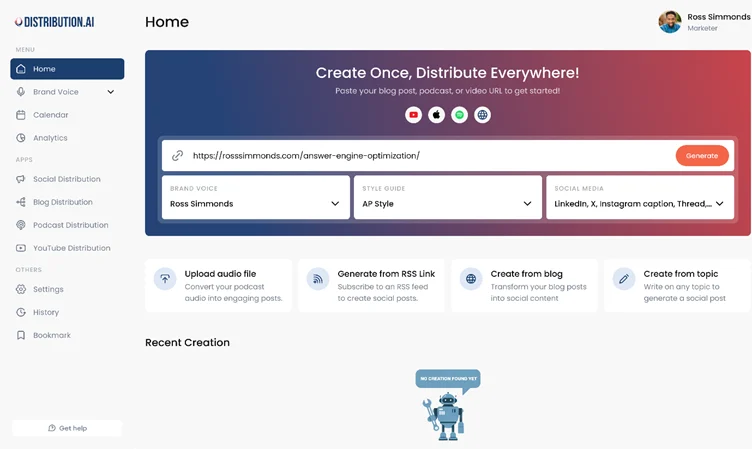
Step 6: Create targeted campaigns
Break down the comprehensive strategy into marketing campaigns with specific deliverables—like a social media campaign, an SEO blog post, or targeted advertising on search engines.
For instance, a SaaS company can run several B2B marketing strategies, such as a LinkedIn campaign highlighting case studies, and a content marketing strategy publishing “how-to” blogs and competitor comparison pages.
Step 7: Measure and optimize
Use tools like Google Analytics, SEMrush, or other social listening and social media management tools to track what’s working.
For example, with Google Analytics, SEMrush, you can review how your website and blog perform. Using these insights, you can re-optimize blogs, create new ones using top keywords.
Similarly, using tools like Distribution AI, you can track the click-through rates, engagement rates, top-performing posts, etc., across social media platforms. This way, you can refine your marketing strategy and double down on content formats that perform the best.
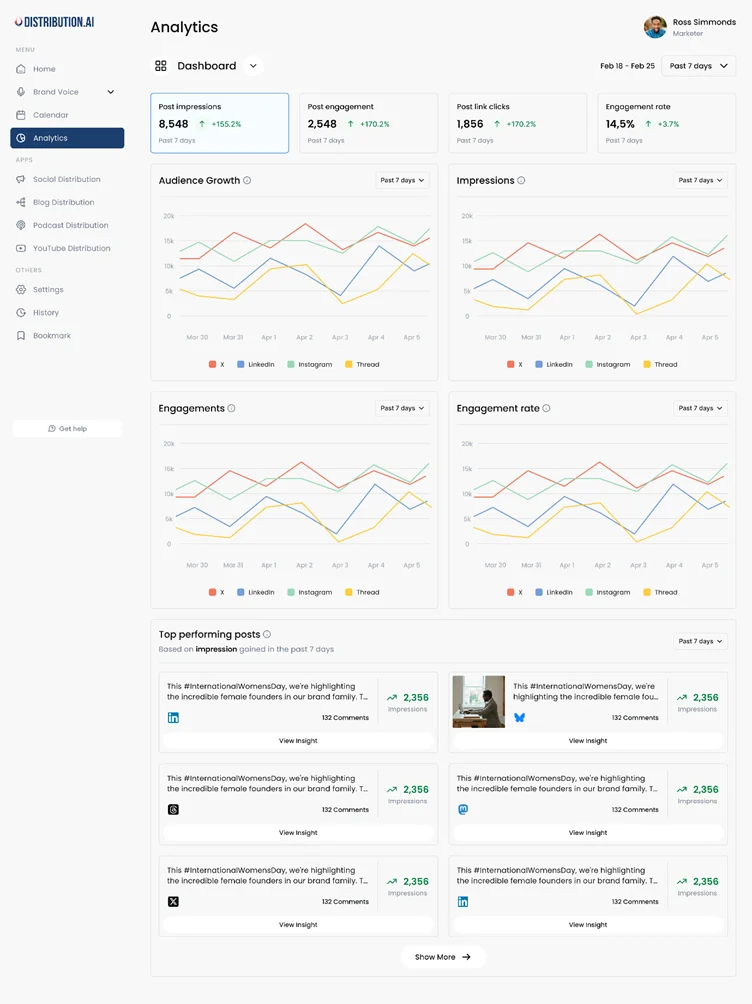
11 Marketing Strategies That Work
1. Data-driven personalization
Consumers expect recommendations and messages that are tailor-made for them. They pass anything that feels generic.
Here are some statistics that highlight the importance of personalization:
- 76% of consumers get frustrated when companies don’t deliver personalized interactions.
- 65% of US consumers choose brands that personalize experience across touchpoints, including websites, emails, and promotions.
- 96% of consumers are more likely to purchase after receiving a personalized message.
Consider deep segmentation, beyond demographics, such as preferences, browsing behavior, engagement frequency, and purchase history to personalize everything—from emails to product recommendations—just like Netflix.
Netflix gives a hyper-personalized experience by analyzing user viewing history, location, watch duration, preferred genres, and even skip behavior to recommend shows that are highly likely to appeal.
Why it works:
- Increases engagement as the content is customized
- Reduces friction by eliminating irrelevant messaging
- Maximizes ROI with fewer wasted impressions
Actionable tips:
- Dynamic content: Base your website, email content, product recommendations, and offers on what you know about the visitor. For instance, “Before you searched for X, you may like Y” is a common content type used across eCommerce platforms.
- Behavior-based triggers: Send automated emails or notifications when a user abandons cart, browses certain categories, or hasn’t visited in a while.
- Test & measure: A/B test different levels of personalization and track metrics like CTR, conversion rate, dwell time, and repeat purchases to scale what works.
2. Content marketing and distribution
Create content that resonates with your target audience. Talk about their purchase journey, pain points, challenges, and successes. Plus, leverage content formats that appeal to your target customers and pair them with a solid content distribution strategy so your content reaches the right people.
For example, LinkedIn video content consumption has grown with a 36% year-over-year increase from 2024 to 2025. Hence, you can create how-to videos, targeted ads, video marketing campaigns, etc., to capture audience attention.
Autodesk has a great content marketing and distribution strategy. It runs “Project Bonfire” which uses UGC and industry publications, with content shared via RSS feeds, magazines, etc. They also create inspiring content on sustainability and education.
Besides, Autodesk is also active on social media platforms like LinkedIn, Instagram, YouTube, Facebook, and Twitter (now X), with the highest number of followers on LinkedIn.
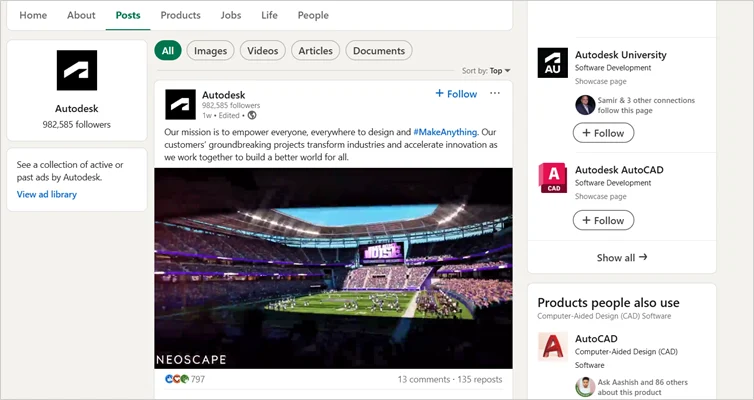
Why it works:
- Builds trust and authority by educating the audience and positioning the brand as a thought leader
- Improves SEO and drives consistent traffic
- Delivers sustainable value, such as blogs generating traffic and leads even long after publishing
Actionable tips:
- Mix formats & channels: Leverage multiple distribution channels. For example, blogs for depth, short video/reels for awareness, podcasts or webinars for deeper engagement.
- Keyword & topic research: Use SERP research and tools (Ahrefs, SEMrush) to find what questions your audience is asking. Create content that answers the top queries.
- Repurpose and distribute: Turn a blog into a reel, infographic, LinkedIn post, or Instagram image. Push content where your audience already is. That increases reach without content creation from scratch.
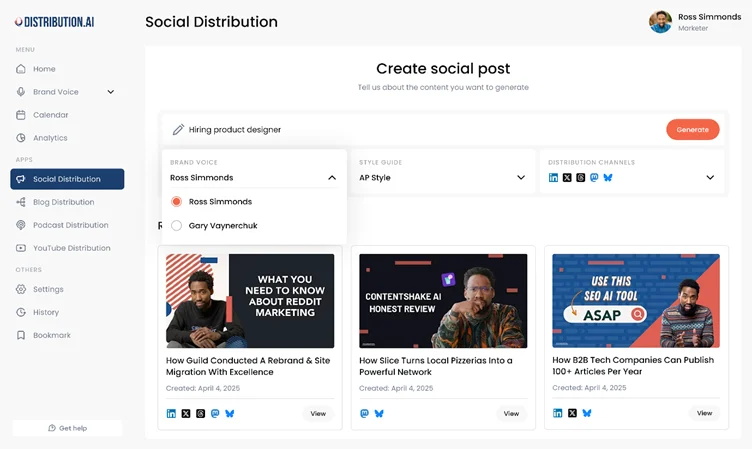
3. Influencer marketing strategy
This is one of the fastest-growing marketing strategies. As per reports, 86% of consumers purchase influencer-recommended products at least once a year. Influencer partnerships help you reach new customers, and the user-generated content they share (product photos, reviews, unboxings, stories) helps build social proof.
Notion promotes its productivity tool through influencers like Ali Abdaal. Ali Abdaal has made several review videos on Notion, promoted the tool on X, and also has his productivity dashboards up for sale at the Notion Marketplace.
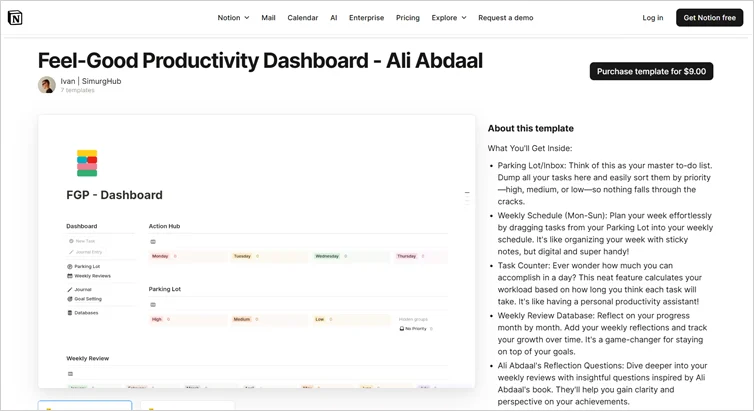
Why it works:
- Authentic content gets higher trust
- Micro-influencers are cost-efficient and often have more engaged audiences
- UGC builds community and helps with social proof, often boosting conversion
Actionable tips:
- Micro-influencer and niche creators: Find influencers with smaller but engaged audiences in your niche. Provide them with product / creative freedom so they can produce authentic content their audience loves.
- Incentivize UGC: Run contests, ask for reviews/photos, offer rewards or recognition. For example, feature customer stories in social posts or on your site to encourage more reviews and user-generated content.
- Monitor what’s happening: Track the user-generated content and what creators are making around your niche. If something starts trending, prepare to respond or amplify.
4. Voice search optimization
Optimizing your content and website for voice search means adapting to how people speak to devices. It involves using conversational, question-based language, long-tail keywords, schema markup, FAQ content, and strong local SEO to create your content.
Optimizing for voice search increases your website’s visibility in voice search results and featured snippets. Plus, quick and hands-free information access makes conversions more likely.
Starbucks optimizes its landing page for voice search to ensure it appears when customers ask voice assistants or Google Search by Voice questions like “Where’s the nearest Starbucks open now?” or “What’s on the menu?” This includes making information like the nearest location, hours, and menus accessible by search engines and voice assistants.
Why it works:
- Captures the increasing share of queries done by voice on mobile devices
- Improves chances of showing up in featured snippets or local voice search results
- Makes your content more intuitive and helpful, boosting both search engine optimization (SEO) and customer experience
Actionable tips:
- Optimize for local SEO & ‘near me’ searches: Ensure your Google Business Profile is up-to-date; include name, address, contact, and other essential data consistently.
- Create FAQ pages: Create content in Q&A format to address common user queries.
- Improve site speed and mobile-friendliness: Optimize website for fast loading times to improve voice search visibility and search rankings.
5. Niche communities marketing
Niche marketing on social media lets you connect with tightly-focused groups united by shared interests. The users authentically participate in these spaces or even co-create with them. Using niche marketing narrows down your audience, reduces competition, and helps you reach a smaller, loyal segment of potential customers.
Red Bull actively participates in niche sports communities on Reddit—subreddits around skateboarding, wingsuit flying, and other extreme sports. The brand uses stories, UGC, and videos to position itself as a member and supporter of the community. This helps Red Bull turn fans into collaborators who can influence and create market impact.
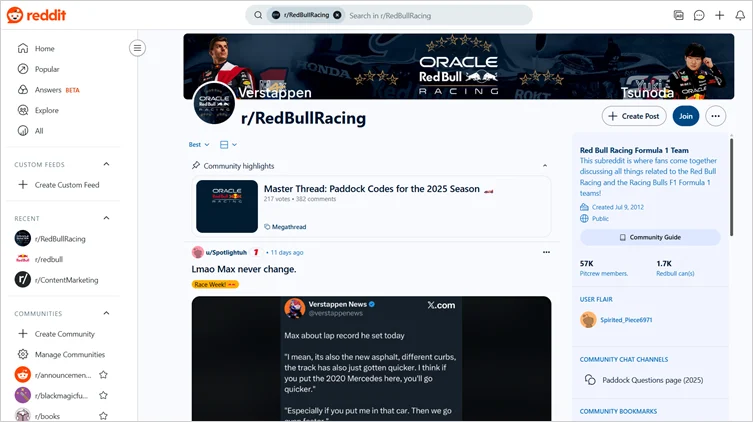
Why it works:
- Builds engagement and trust as members feel seen, heard, and valued
- High chances of word-of-mouth and referrals in tight-knit groups
- Richer insights and faster feedback loops, helping you learn what the audience wants
Actionable tips:
- Contribute value first: Instead of pushing your product, answer questions, share useful content, engage in discussions, and add value to discussions.
- Co-create with members: Invite members to help shape brand content, offer product ideas, and share stories/photos for UGC.
- Maintain consistency & exclusivity: Offer insider perks, early access to content or products, exclusive groups or beta testers to build belonging.
6. Short-form video marketing
Among all marketing strategies, investing in short-form videos (typically under 60-90 seconds) can help you boost brand awareness. Whether Instagram or TikTok Reels, or YouTube Shorts, these videos can help you share tips, tutorials, teasers, or product reveals to keep your audience engaged.
Fitbit uses short video marketing across Instagram and TikTok to highlight real user testimonials, health tips, product benefits, and more content to connect with its audience.
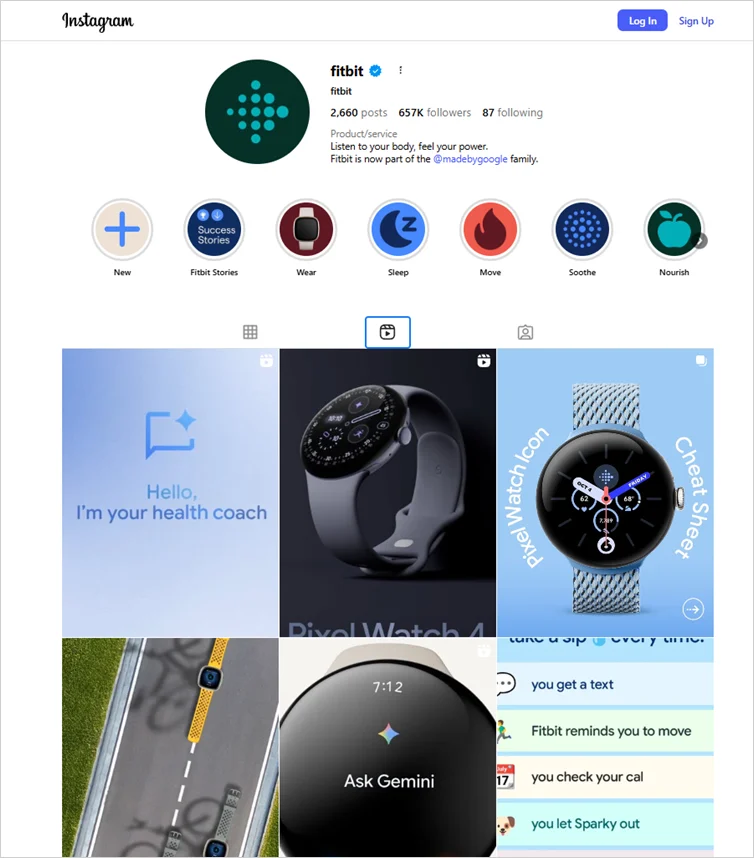
Why it works:
- Aligns with the audience’s changing attention spans and content consumption patterns
- High shareability and potential for wider reach
- Helps with discoverability on platforms that favor short-form videos like YouTube, Instagram, or TikTok
Actionable tips:
- Hook fast: Use the first 3 seconds to hook your viewer. Start with an attention grabber—a visual, a question, or a surprising fact.
- Use captions & text overlays: Give captions for your videos, as many users watch them with audio turned off.
- Repurpose content: Repurpose video content to create multiple clips and reels. Plus, use testimonials and other user content to create reels.
7. Interactive content strategy
Using content that requires the audience to participate performs the best, especially on social media. Running polls, surveys, and quizzes, embedding calculators on websites, interactive infographics, and chatbots help you engage your audience. This boosts time spent, helps collect insights, and improves user experience.
Atlassian has a “Quiz” section on its website where users can input their answers to understand their workplace dynamics. For example, the communication style quiz helps you identify the work communication style of everyone in the team.
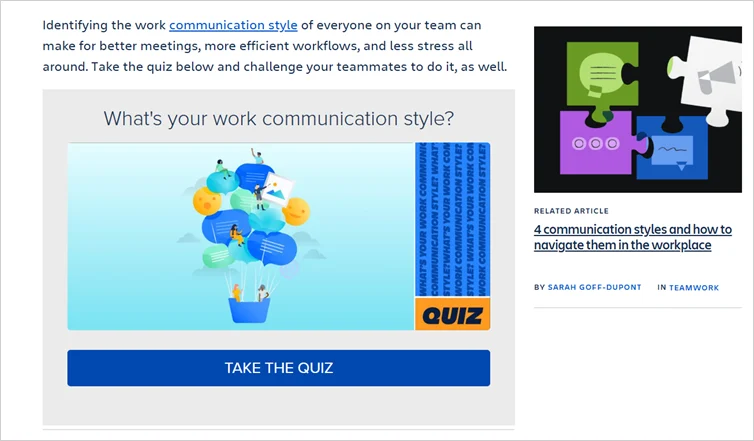
Why it works:
- Encourages deeper engagement and longer session times
- Generates data and insights about what the audience cares about, which you can use for personalization or content strategy
- Makes content more shareable
Actionable tips:
- Embed interactive content: Use quizzes, tools in your content marketing funnel (blogs, landing pages, emails) so it drives conversion or lead capture.
- Mobile-friendly: Optimize for mobile to ensure fast load times and easy access.
- Use follow-ups: Send follow-up content based on interaction results. For example, when someone completes a quiz, send them content or product suggestions related to their quiz result.
8. Guerrilla tactics and marketing strategy
Guerrilla marketing strategies use low-budget, high-impact creative stunts to grab audience attention in both online and offline channels. Instead of competing with massive ad spends, you rely on surprise, humor, and originality to make your marketing campaigns memorable and shareable.
We found a real-life example of an offline guerrilla marketing strategy on Reddit. A UK tabloid relaunched its classifieds section with a bold print ad: A man opening his coat (like a flasher) alongside the tagline “It doesn’t have to be big to get noticed.” The word play became memorable, buzz-worthy, and over the next 2 years the newspaper’s classifieds revenue tripled.
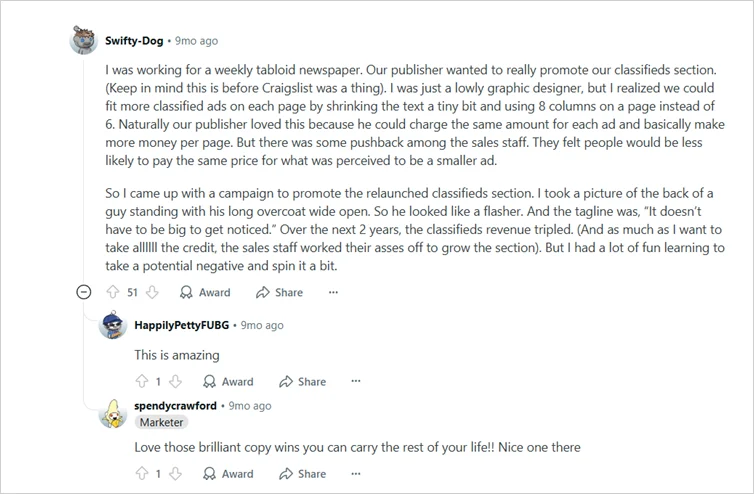
Another guerrilla marketing example would be Samsung’s “Captura la noche” or “Capture the night” digital ad campaign for its new Galaxy S23 launch. Samsung created a web platform where S23 users could upload night photos captured with their phones. The platform then analyzed each photo and defined each one’s style of music. The result? Users could identify the kind of music they like and use the platform’s creativity to make original music of their own.
Why it works:
- Breaks through ad fatigue by being unexpected
- Sticks in people’s memory because it’s tied to humor or surprise
- Often earns organic traffic and PR coverage when shared online
Actionable tips:
- Start with your audience’s environment: Think where they commute, shop, or attend events—and design a stunt that will catch them off-guard.
- Tie creativity back to your brand message: Bold ideas work only if the audience remembers what you stand for.
- Test small and then scale: Pilot an activation in one location, event, or platform. Measure the buzz and ROI, then expand if it works.
9. Meme marketing strategy
Around 44% of people aged 18 to 34 share online memes daily. Audience relates to the humor in memes, which typically highlights habits, frustrations, or current trends. They are less formal, low-budget, and can be used across social media posts, community channels, or ad creatives.
Here’s an example of Gong highlighting a relatable moment for sales reps who love a smooth, no-resistance buyer, which is rare.
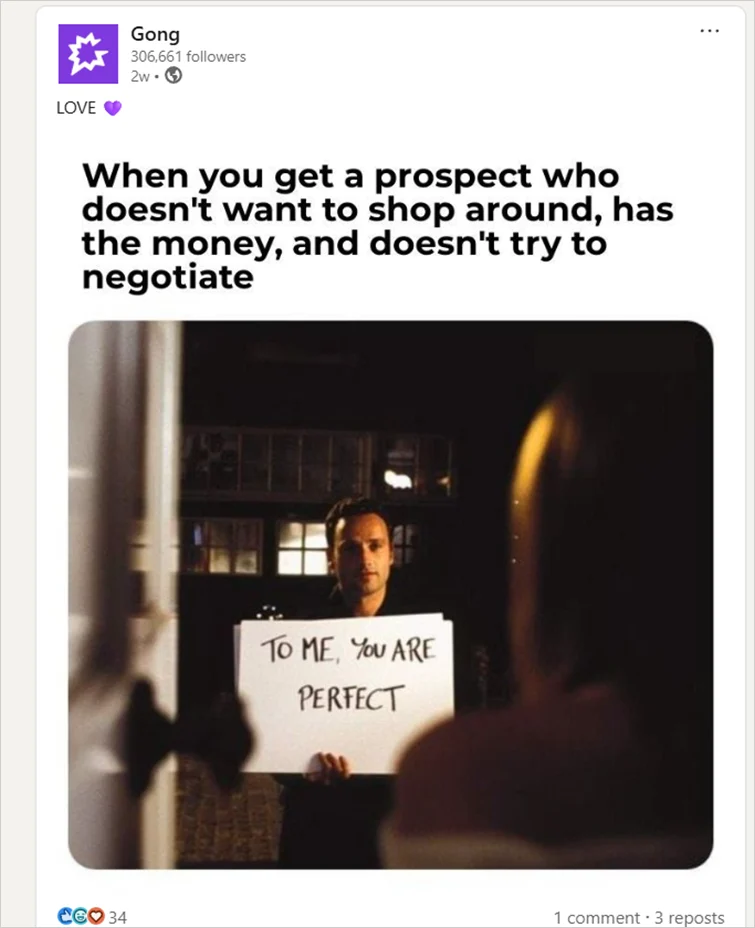
Why it works:
- Memes make your brand more human and relatable
- High chances of shareability, meaning more reach with low investment
- Shared frustrations through memes resonate with the audience
Actionable tips:
- Share pain points & inside jokes: Identify what niche users dislike or struggle with and create memes on that. For example, SaaS pain points can be meetings that go nowhere, dashboards that don’t update, or tool integrations failing.
- Mix organic and paid where possible: Post memes organically to build community; when one does well, amplify with a small ad budget to reach more people.
- Keep voice consistent & avoid off-brand risk: Memes can offend or misfire. Make sure the humor fits your audience, brand values, and is easy to understand.
10. AI-powered content repurposing
Though we already gave you a tip to repurpose content in the content marketing strategy discussion, content repurposing deserves a place of its own.
Often underrated, content repurposing is a vital marketing strategy. In fact, a survey revealed that 46% of marketers believe repurposing is more effective than creating content from scratch.
With AI repurposing tools, marketers can now scale one content asset into dozens of platform-specific pieces—blogs, infographics, carousels, social media text posts, emails, and more.
For instance, Distribution AI takes your existing content—blogs, videos, podcasts—and generates multiple versions of social media posts, including carousels and images. Here’s how it helps:
- Less time spent creating content
- Platform-form specific content generated within minutes, all aligned to your brand voice
- Automatic scheduling and publishing across social media platforms
- Broader reach across social media with consistent posting
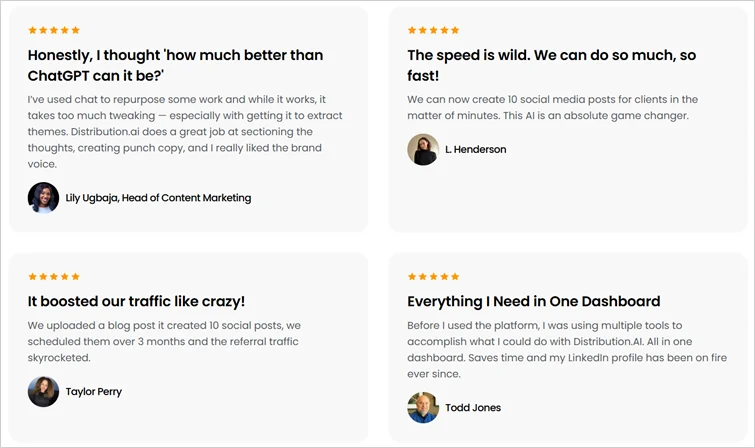
Why it works:
- Automating repurposing saves time and resources
- Improves brand visibility by pushing consistent content across multiple platforms
- Unlocks organic traffic growth through wider distribution
Actionable tips:
- Align content with platform types: Each repurposed piece should align with platforms, such as professional insights for LinkedIn, visual snippets for Instagram, and conversational tips for Reddit.
- Use AI tools to test variations: Assess all content versions for tone, format, or headlines— then double down on what resonates.
- Track performance: Monitor how each repurposed content performs to see which marketing channels deliver the best ROI.
11. Referral marketing strategy
Referral marketing leverages your existing customers to bring in new ones by offering rewards, discounts, or perks when they successfully refer others. It’s word-of-mouth with a structured incentive.
Restream, a live streaming platform, runs a simple cash-based referral program. Restream users and their referrals receive $10 in withdrawable cash. Streamers simply need to share their unique links during broadcasts to monetize their content.
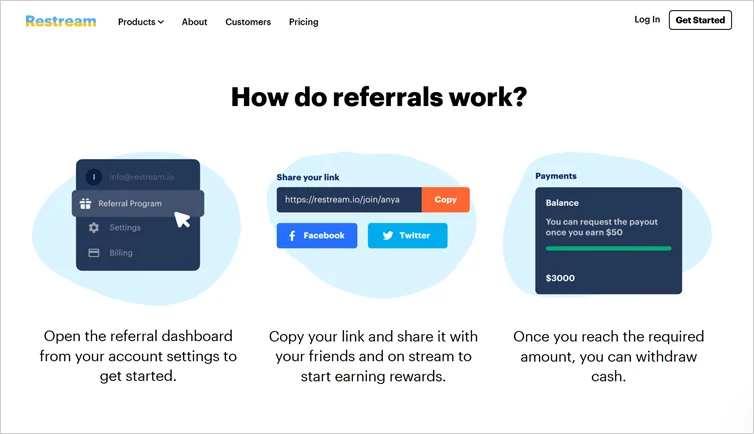
Why it works:
- Turns satisfied customers into brand advocates
- Builds trust faster because recommendations come from known people
- Cost-effective compared to cold acquisition
Actionable tips:
- Offer mutual rewards: Give something to both the referrer and the referee (discount, credit, free trial extension).
- Promote the program actively: Use email reminders, in-app banners, and onboarding prompts to promote the referral program.
- Track and optimize: Measure referral ROI, see which incentives work best, and test new formats (tiered rewards, gamification, VIP perks).
Level Up Your Marketing Strategy with Distribution AI
Marketing in 2025 has endless opportunities for brands that are ready to adapt, innovate, and connect. From short-form videos to community-building on platforms like Reddit, each of these marketing strategies can help you elevate your brand and deliver measurable results.
But don’t just take our word for it—start implementing. Instead of juggling everything manually, let tools like Distribution AI handle the heavy lifting—so you save time, resources, and keep your marketing consistent.
Frequently Asked Questions
Promote, repurpose & distribute your content with AI
Start 15-Day Free Trial